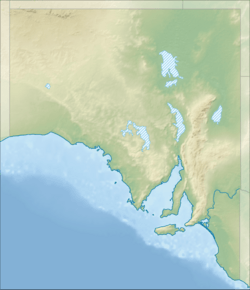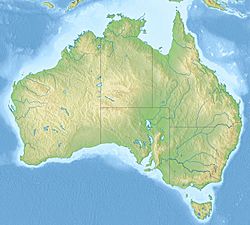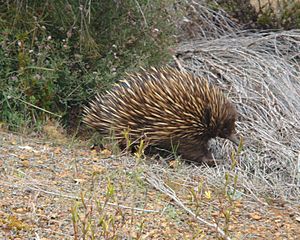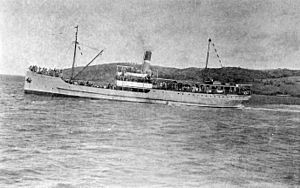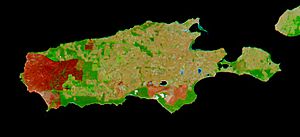Kangaroo Island facts for kids
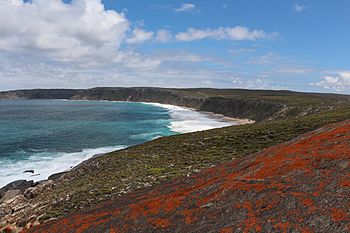
View of the South West of the island
|
|
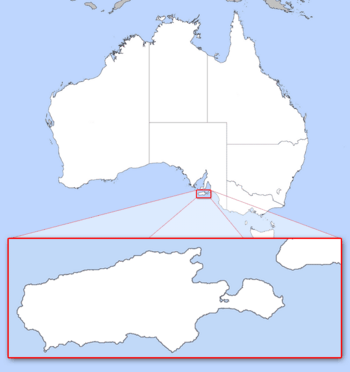 |
|
| Geography | |
|---|---|
| Location | Great Australian Bight |
| Coordinates | 35°50′S 137°15′E / 35.833°S 137.250°E |
| Area | 4,405 km2 (1,701 sq mi) |
| Length | 145 km (90.1 mi) |
| Width | 90 km (56 mi) – 57 km (35 mi) |
| Coastline | 540 km (336 mi) |
| Highest elevation | 307 m (1,007 ft) |
| Administration | |
|
Australia
|
|
| State | South Australia |
| LGA | Kangaroo Island Council |
| Largest settlement | Kingscote (pop. 2,034) |
| Demographics | |
| Population | 4,702 (2016) |
| Pop. density | 1.07 /km2 (2.77 /sq mi) |
Kangaroo Island is Australia's third-largest island. Only Tasmania and Melville Island are bigger. It is located in the state of South Australia, about 112 km (70 mi) southwest of Adelaide. The closest point to the mainland is Snapper Point, which is 13.5 km (8.4 mi) from the Fleurieu Peninsula.
Long ago, Aboriginal people lived on the land that is now Kangaroo Island. However, they left no trace in the historical record when rising sea levels turned the land into an island thousands of years ago. Later, in the early 1800s, sealers and whalers visited the island. Permanent settlement began in 1836 when the colony of South Australia was established.
Today, the island's main activities are farming, fishing (especially for southern rock lobster), and tourism. Kangaroo Island has many nature reserves. These areas protect its natural plants and animals. The biggest and most famous reserve is Flinders Chase National Park on the western side of the island.
Contents
Exploring Kangaroo Island's History
The first lighthouse in South Australia was built on Kangaroo Island at Cape Willoughby in 1852. Other lighthouses followed, including Cape Borda Lightstation in 1858, Cape du Couedic Lighthouse in 1906, and Cape St Albans Lighthouse in 1908. All these lighthouses are still working today.
The largest town on Kangaroo Island is Kingscote. It was founded on July 27, 1836. This makes it South Australia's first colonial settlement. People once thought Kingscote could become the capital of South Australia. However, the island did not have enough resources to support such a large city. So, Adelaide was chosen instead.
Amazing Wildlife and How It's Protected
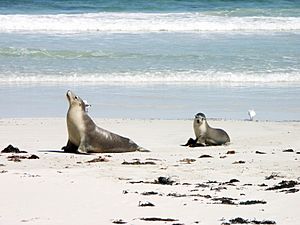
More than half of Kangaroo Island is still covered in its original plants. A quarter of the island is protected in National Parks, Conservation Parks, and Wilderness Protection Areas. Some of the main protected places are:
- Flinders Chase National Park
- Seal Bay Conservation Park
- Cape Gantheaume Conservation Park
- Cape Bouguer Wilderness Protection Area
- Ravine des Casoars Wilderness Protection Area
Because Kangaroo Island is separated from mainland Australia, animals like foxes and rabbits are not found there. It is also against the rules to bring them to the island. If you have a cat, you must register and microchip it. This helps protect the native wildlife.
Native Animals of Kangaroo Island
Many animals are native to Kangaroo Island. These include the Kangaroo Island Kangaroo, Rosenberg's Sand Goanna, Southern Brown Bandicoot, Tammar Wallaby, Common Brushtail Possum, Short-beaked Echidna, and New Zealand Fur Seal. Six types of bats and frogs also live here.
The Kangaroo Island Dunnart is a small marsupial (a type of mammal) that eats meat. It is the only vertebrate (animal with a backbone) found only on Kangaroo Island. This means it is endemic to the island.
Some animals like the Koala, Common Ringtail Possum, and Platypus were brought to the island by people. They still live there today.
Sadly, Kangaroo Island once had its own type of Emu, called the Kangaroo Island Emu. But it became extinct between 1802 and 1836. This might have been due to bushfires or hunting by early visitors.
Kangaroo Island's Special Bees
Kangaroo Island is famous for its honey and its special Ligurian honey bees. The island has the only pure-bred and disease-free group of these bees in the world. Selling pure-bred queen bees to other places is an important business for the island. Because of this, there are strict rules about bringing bee products or equipment onto the island. This helps keep the bees healthy and pure.
Farming and Local Products
The island's economy is mostly based on agriculture. Farmers grow grapes, produce honey, and raise sheep for wool and meat. They also grow grains. In the past, sheep farming was the most important type of agriculture. But now, farmers also grow other crops like potatoes and canola. Raising cattle for beef has also become more popular, especially in areas with more rainfall.
Tourism and fishing are also very important. Over 186,000 people visit the island each year. Some of the best southern rock lobsters come from the island's rugged south coast. Kangaroo Island also has South Australia's only eucalyptus oil distillery. This distillery makes oil from the endemic Kangaroo Island narrow leaf mallee tree, which grows only on the island.
Fun Things to Do and See
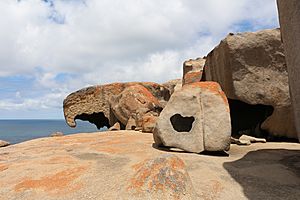
Kangaroo Island is a very popular place for tourists. More than 140,000 people visit each year. Many international visitors, especially from Europe, come to see the island. Some of the most popular places to visit are:
- Seal Bay Conservation Park: Here, you can take guided walks among sea lions resting on the beach.
- Flinders Chase National Park: This park has amazing places like Remarkable Rocks, Admiral's Arch, and lighthouses at Cape Borda and Cape du Couedic. It also has many walking trails and camping spots.
- Cape Willoughby: You can visit the historic lighthouse here.
- Kelly Hill Caves: Explore these fascinating caves.
- Little Sahara: These are huge sand dunes on the south coast, great for sandboarding!
- Mount Thisby (also called Prospect Hill): Climb to the top for amazing 360-degree views of the island.
- Murray Lagoon: A great spot to see many different kinds of water birds.
- Kangaroo Island Wildlife Park: See and learn about local wildlife.
- Raptor Domain: Watch amazing bird of prey shows and reptile presentations.
- Hanson Bay Wildlife Sanctuary: Take a koala walk or a night tour to see local animals.
- Honey farms: Visit farms that sell delicious honey from the Ligurian bees.
- Emu Ridge Eucalyptus Oil Distillery: See how eucalyptus oil is made using old methods.
For swimming, the northern beaches like Emu Bay, Stokes Bay, or Snellings Beach are safe. Island Beach on the Dudley Peninsula is also good. The south coast has strong undertows, so it's better for very strong and experienced swimmers. Kingscote has an ocean pool that is free to use and easy to get to.
Getting Around Kangaroo Island
Travel by Sea

Most people and goods travel to and from Kangaroo Island by ferry. Two companies currently offer ferry services. Kangaroo Island SeaLink uses two ferries, the Sealion 2000 and the Spirit of Kangaroo Island, for both passengers and freight. Kangaroo Island Connect started services in 2018 and carries only passengers.
For many years, from 1907 to 1961, the SS Karatta was the main ship for freight and passengers between Port Adelaide and Kingscote. Later, other ships like the MV Troubridge and the Island Seaway took over. Today, SeaLink is the main ferry operator for the island.
Travel by Air
In 2017, Qantas announced direct flights to Kangaroo Island from Adelaide and Melbourne. These flights started in December 2017. During the busy summer months, there are five flights a week from Adelaide. After Easter, this reduces to three flights a week. There are also two flights a week from Melbourne during December and January. The Kingscote Airport was upgraded in May 2018, costing $18 million.
Bushfires on the Island
Fires in 2007
In December 2007, lightning strikes caused several fires on Kangaroo Island. Before they were put out on December 16, 2007, over 20% of the island had burned. This was about 900 square kilometres (220,000 acres). Most of the burned area was within National Parks and Conservation Reserves. The worst fire was in Flinders Chase National Park. It burned 630 square kilometers, which was 85% of the park.
Fires in 2020
In January 2020, Kangaroo Island was one of many places affected by major bushfires across Australia. These fires were part of the 2019–20 Australian bushfire season.
On Kangaroo Island, several fires burned over 1,500 square kilometres (370,000 acres). An emergency warning was issued on January 3, 2020, as the fire moved towards Vivonne Bay. The town of Parndana had to be evacuated. Sadly, two people died on Kangaroo Island because of these fires.
Images for kids
-
Eucalyptus cneorifolia along Cape Willoughby Road, Kangaroo Island
See also
 In Spanish: Isla Canguro para niños
In Spanish: Isla Canguro para niños


